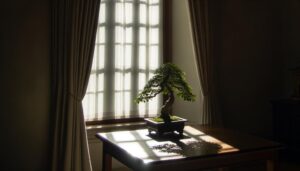Do Bonsai Pots Need Drainage Holes for Healthy Roots?
Bonsai pots must have drainage holes to facilitate ideal water management and soil aeration. Adequate drainage prevents waterlogging, which can lead to root rot and anaerobic conditions detrimental to the tree's health.
Properly designed holes allow excess water to escape, maintaining a balanced moisture level in the soil. They also enhance oxygen availability, essential for root respiration and overall metabolic processes.
Without sufficient drainage, soil compaction and fungal growth become significant risks. Using a well-draining soil mix alongside drainage holes ensures an environment conducive to robust root development.
Explore further to understand the crucial role of pot selection in bonsai cultivation.
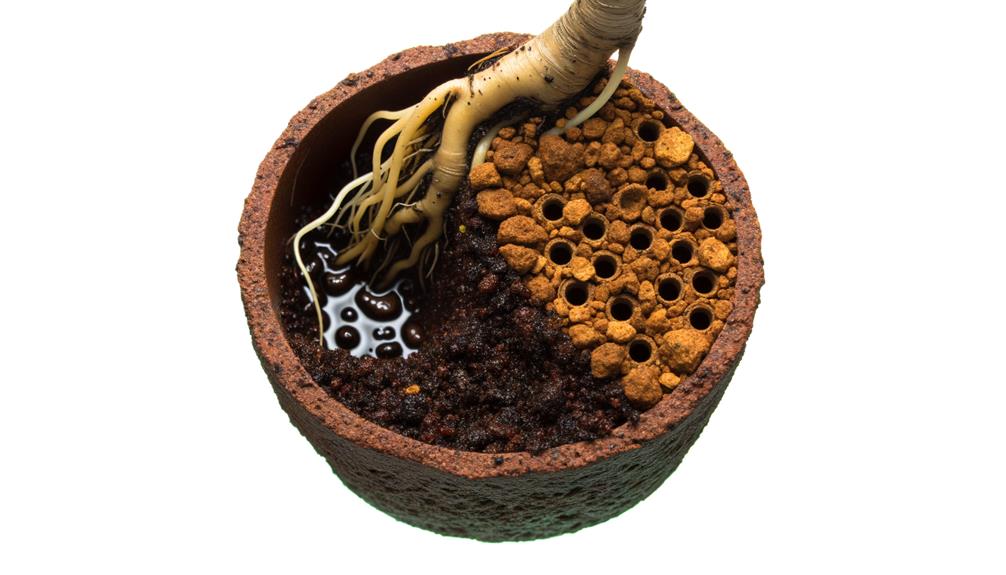
Key Takeaways
- Bonsai pots need drainage holes to prevent waterlogged soil and root rot.
- Drainage holes facilitate optimal soil aeration, promoting healthy root development.
- Excess water escapes through drainage holes, maintaining the ideal moisture balance.
- Well-draining soil mix complements drainage holes to create a healthy root environment.
- Proper drainage reduces harmful fungal growth and soil compaction.
Importance of Drainage
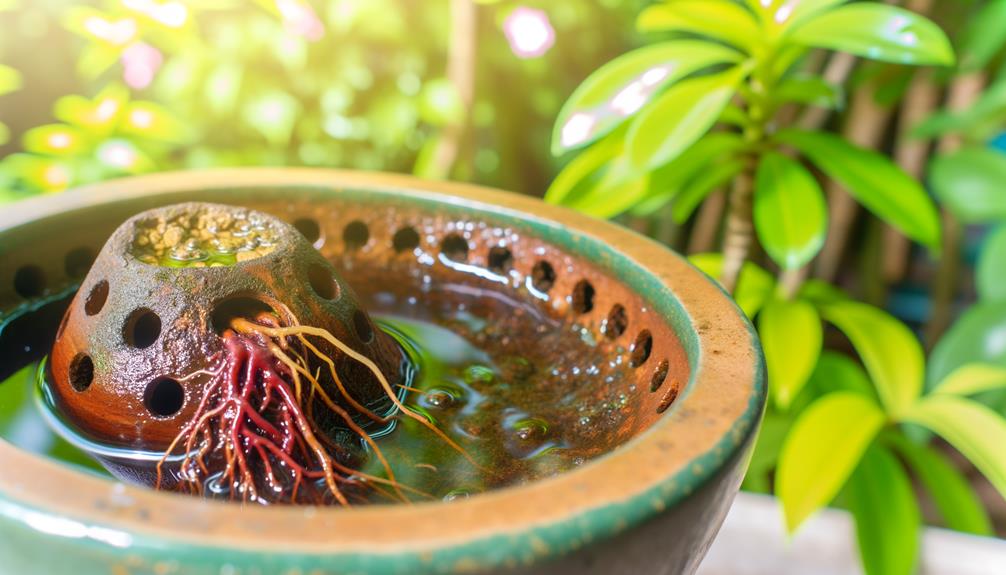
Maintaining appropriate drainage in bonsai pots is essential for preserving the health and strength of the tree's root system. It prevents waterlogging and encourages optimal soil aeration. Sufficient drainage aids in the elimination of excess water, avoiding anaerobic conditions that can hinder root respiration.
The existence of drainage holes guarantees that water does not stagnate, reducing the chances of harmful fungal growth and soil compaction. Well-aerated soil is necessary for the roots to access oxygen, vital for cellular respiration and nutrient uptake.
Efficient drainage enables the regulation of soil moisture levels, optimizing conditions for the tree's growth and development. Consequently, drainage holes are essential for maintaining a healthy bonsai ecosystem.
Preventing Root Rot
Preventing root rot in bonsai trees requires careful attention to soil moisture levels and proper drainage practices. Inadequate drainage can lead to waterlogged soil, which creates an anaerobic environment conducive to pathogenic fungal growth. Ensuring the bonsai pot has sufficient drainage holes is crucial; these allow excess water to escape, maintaining an ideal moisture balance.
Using a well-draining soil mixture, typically made up of components like akadama, pumice, and lava rock, further reduces the risk of water retention. Regularly checking soil moisture through touch or moisture meters can proactively address potential issues. Moreover, raising the pot slightly off the ground can enhance drainage efficiency, thereby protecting the delicate root system from the harmful effects of excessive moisture.
Soil Aeration
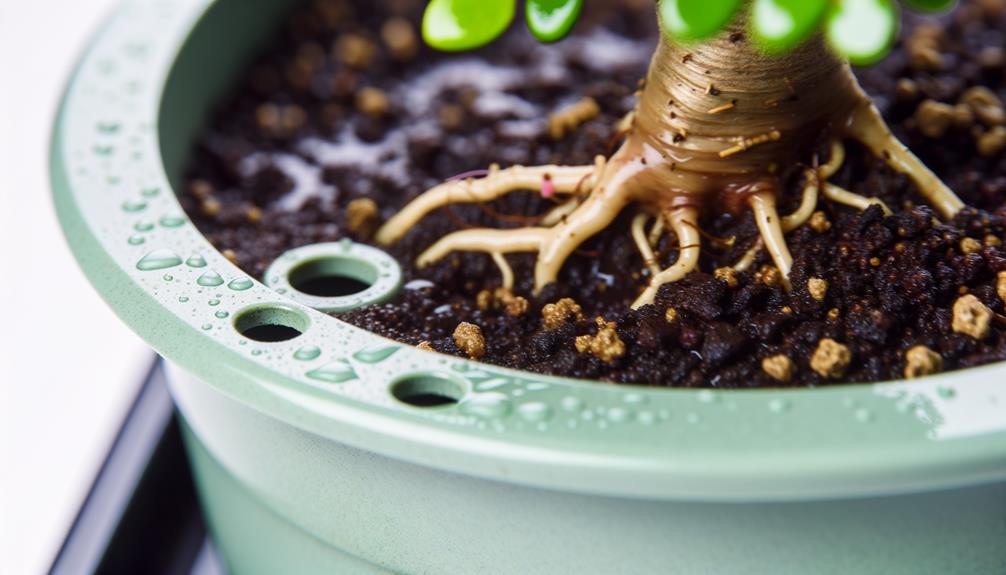
Soil aeration is crucial for maintaining ideal root oxygenation, which is necessary for the metabolic processes of bonsai trees.
Effective drainage holes help prevent water stagnation, thereby reducing the risk of anaerobic soil conditions that can lead to root decay.
Additionally, proper soil structure and granularity are essential in avoiding compaction, ensuring that air pockets remain within the substrate to support healthy root systems.
Root Oxygenation Importance
Best root oxygenation, a pivotal aspect of soil aeration, is necessary for the health and energy of bonsai trees. Adequate oxygen levels in the root zone facilitate essential physiological processes, such as respiration and nutrient uptake. Without proper aeration, roots may suffer from hypoxia, leading to impaired growth and vigor.
Ensuring ideal oxygenation involves selecting an appropriate soil mix and container design, particularly the inclusion of drainage holes. This practice enhances root respiration, promoting cellular metabolism, and facilitates efficient nutrient absorption, essential for growth. It also mitigates root rot by preventing anaerobic conditions and supports beneficial microbial activity in the rhizosphere. Overall, it promotes the structural integrity and longevity of the bonsai.
Understanding these factors is essential for cultivating robust and aesthetically pleasing bonsai specimens.
Preventing Water Stagnation
To sustain ideal root oxygenation and prevent the harmful effects of hypoxia, it is vital to address the issue of water stagnation through effective soil aeration techniques.
Proper drainage in bonsai pots is essential for avoiding water accumulation at the root zone, which can result in root rot and other pathologies.
Utilizing a well-balanced soil mix that includes components such as akadama, pumice, and lava rock can greatly improve soil aeration. These substrates facilitate sufficient air circulation and water percolation, thereby reducing anaerobic conditions.
Additionally, incorporating mesh screens over drainage holes helps prevent soil particles from clogging the drainage system, ensuring continuous water flow and ideal root health.
Therefore, strategic soil composition and drainage management are essential in preserving bonsai vitality.
Soil Compaction Issues
Effective soil aeration is crucial in preventing soil compaction, which can severely restrict root growth and diminish the overall health of bonsai trees. Soil compaction reduces the pore space within the soil matrix, limiting oxygen availability to the roots and impairing water drainage.
Proper aeration guarantees a balance between air and water, crucial for root respiration and nutrient uptake. Drainage holes in bonsai pots facilitate this by allowing excess water to escape, thereby reducing the risk of waterlogged conditions that contribute to compaction.
Enhanced Root Growth:
Promotes a strong root system.
Optimal Water Drainage:
Prevents waterlogging and root rot.
Improved Nutrient Uptake:
Ensures roots access necessary nutrients.
Microbial Health:
Supports beneficial soil microorganisms.
Soil Structure Integrity:
Maintains the soil's physical characteristics.
Water Management
Proper water management in bonsai cultivation is crucial. The drainage holes in bonsai pots play an essential role in preventing waterlogged soil conditions that can lead to root rot. Effective drainage ensures excess water escapes, maintaining an optimal moisture balance in the soil substrate. This balance is vital for facilitating aeration within the root zone, promoting healthy root development and nutrient uptake.
Additionally, drainage holes help mitigate the risk of anaerobic conditions, which can create a breeding ground for harmful pathogens. To achieve efficient water management, it is imperative to use a well-draining soil mix. This mix is typically composed of components like akadama, pumice, and lava rock, which complement the function of drainage holes in promoting a healthy bonsai environment.
Choosing the Right Pot
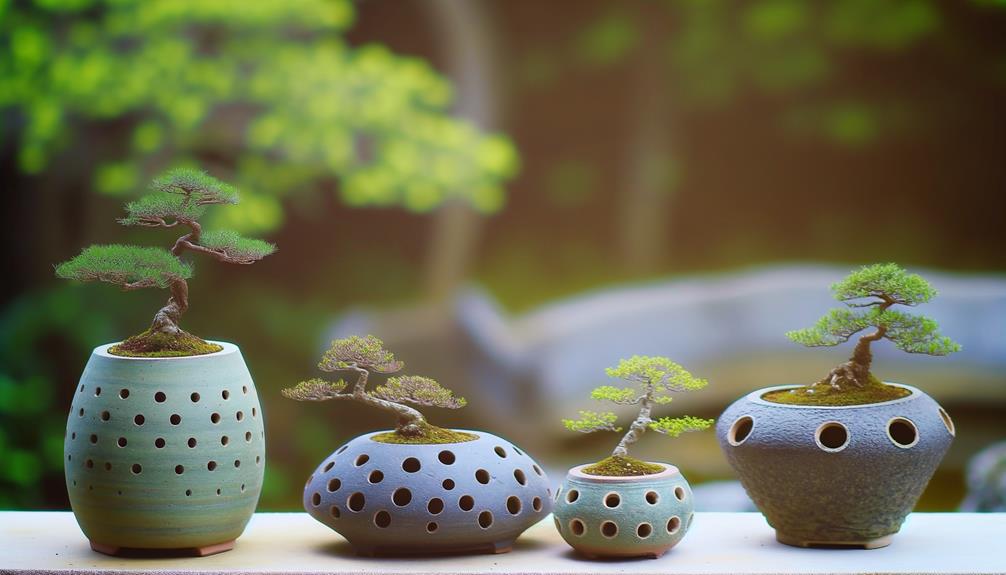
Selecting the appropriate bonsai pot involves considering factors such as material, size, shape, and aesthetic harmony with the tree species. Each of these factors plays a pivotal role in ensuring the best possible growth and visual appeal of the bonsai.
- Material: Choose between ceramic, plastic, or clay, each offering different benefits and drawbacks.
- Size: Make sure the pot is proportionate to the tree's root system and canopy.
- Shape: Match the pot's shape with the style of the bonsai, such as oval, round, or rectangular.
- Aesthetic: The pot should complement the tree's appearance, enhancing its natural beauty.
- Color: Consider the pot's color to harmonize with the foliage and bark, creating a cohesive visual presentation.
These elements collectively contribute to the bonsai's health and presentation.
Alternatives to Drainage Holes
While traditional bonsai pots typically feature drainage holes to prevent waterlogging and promote healthy root growth, there are innovative alternatives available that can effectively manage moisture levels without compromising the tree's well-being.
One such alternative involves the use of high-quality, water-absorbing substrates like akadama or pumice, which provide excellent aeration and moisture regulation. Additionally, incorporating a layer of activated charcoal at the pot's base can help absorb excess water and prevent root rot.
Self-watering pots equipped with capillary action systems offer another solution by ensuring consistent moisture without oversaturation. These methods, when properly implemented, can maintain ideal hydration and aeration levels, thereby supporting the bonsai's health and development in the absence of traditional drainage holes.
Best Practices for Bonsai Care
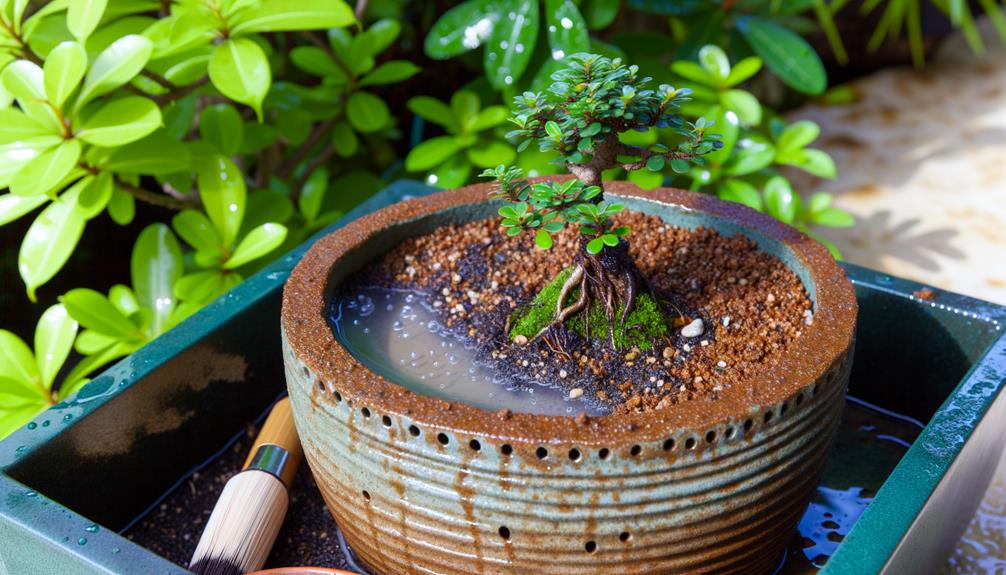
Effective bonsai care hinges on a triad of critical practices:
- Precise watering frequency tailored to species-specific needs,
- Ideal soil composition to guarantee sufficient aeration and nutrient availability, and
- Meticulous pruning and shaping to maintain aesthetic form and promote healthy growth.
Understanding the interplay between these factors is crucial for sustaining bonsai health.
Implementing these best practices will greatly improve the longevity and visual appeal of your bonsai.
Watering Frequency Guidelines
Determining the best watering frequency for bonsai trees involves a thorough understanding of various factors, including tree species, pot size, soil composition, and environmental conditions. Proper watering is vital to maintain the delicate balance between hydration and aeration in the root system. Overwatering can lead to root rot, while under-watering can result in dehydration and stress.
To optimize watering frequency, consider the following guidelines:
- Monitor soil moisture levels regularly using a moisture meter.
- Guarantee the pot has adequate drainage to prevent waterlogging.
- Adjust watering frequency based on seasonal changes and indoor vs. outdoor placement.
- Observe the tree's foliage for signs of overwatering (yellowing leaves) or underwatering (wilting leaves).
- Employ a watering schedule tailored to the specific needs of the bonsai species.
Soil Composition Essentials
Understanding the importance of proper watering frequency naturally leads to an examination of soil composition, which plays a critical role in the health and growth of bonsai trees.
An ideal bonsai soil mix typically includes a balance of akadama, pumice, and lava rock. Akadama, a type of hard-baked clay, provides moisture retention and nutrient accessibility. Pumice enhances aeration and root development, while lava rock ensures drainage and structural integrity.
This trifecta creates a well-draining yet moisture-retentive environment, crucial for preventing root rot and promoting robust growth. Additionally, organic components such as pine bark or compost can be integrated to improve microbial activity and nutrient content.
Precision in soil composition directly influences the health and longevity of bonsai specimens.
Pruning and Shaping Tips
Mastery of pruning and shaping techniques is fundamental for cultivating the aesthetic and structural integrity of bonsai trees. Precision in pruning promotes healthy growth, while shaping defines the tree's visual impression. Annual pruning should address both structural and maintenance cuts. Structural pruning involves removing major branches to establish the tree's form, whereas maintenance pruning focuses on minor trims to manage foliage density.
Key tips for effective pruning and shaping include:
- Use sharp, clean tools to prevent disease transmission and guarantee clean cuts.
- Identify and remove crossing branches to maintain clear lines and prevent damage.
- Implement wire training to guide branches into the desired shape.
- Prune during dormancy to minimize stress and encourage vigorous growth.
- Monitor and adjust regularly to refine the tree's structure and health.
Conclusion
The absence of drainage holes in bonsai pots could spell definite doom for these delicate plants, leading to catastrophic root rot and suffocating soil conditions. Proper drainage is not just beneficial; it is absolutely crucial for best water management and soil aeration.
Selecting the appropriate pot becomes a matter of life and death for the bonsai. Therefore, meticulous adherence to best practices guarantees the thriving existence of these miniature botanical marvels.

